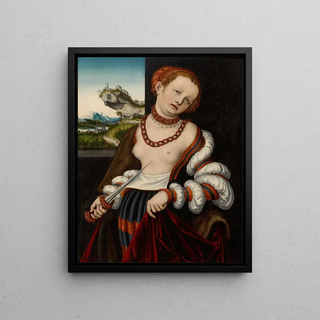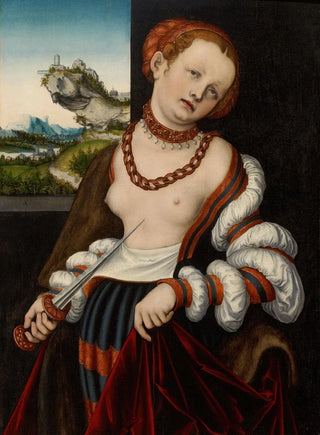Art print | The Suicide of Lucretia - Lucas Cranach the Elder


View from behind

Frame (optional)
The Art print of Lucretia's suicide - Lucas Cranach the Elder – Captivating introduction
Lucretia's suicide is an iconic Art print by Lucas Cranach the Elder, a painter of the German Renaissance whose talent left a lasting mark on his era. This canvas, depicting a tragic moment from Roman history, portrays the noble Lucretia, whose tragic fate reflects the values of virtue and honor. Through this poignant scene, the artist invites the viewer to contemplate moral dilemmas and the devastating consequences of shame and betrayal. The depiction of Lucretia, both beautiful and desperate, evokes a deep emotion, capturing the very essence of her sacrifice. The work, in itself, is not limited to a simple narrative but becomes a mirror of human struggles, transcending time and space.
Style and uniqueness of the work
Cranach the Elder stands out with his unique style, combining fine detail with a vibrant color palette. In the Lucretia's suicide Art print, the composition is carefully orchestrated, each element contributing to the visual storytelling. Lucretia's posture, her face marked by pain and determination, is accentuated by delicate drapery that emphasizes the emotional tension of the scene. The colors, ranging from warm tones to darker shades, create an atmosphere that is both tragic and intimate. The artist skillfully plays with light, highlighting Lucretia's face while plunging the rest of the scene into suggestive shadow. This approach adds psychological depth to the work, allowing the viewer to feel the intensity of the moment. Thus, the uniqueness of this piece lies not only in its technique but also in how it engages the audience in an emotional dialogue.
The artist and his influence
Lucas Cranach the Elder, born in 1472, is one of the masters of the German Renaissance. His work is marked by a profound humanism, exploring themes of morality and beauty. Cranach established himself as a court artist, notably with the family of Frederick III of Saxony, which allowed him to

Matte finish

View from behind

Frame (optional)
The Art print of Lucretia's suicide - Lucas Cranach the Elder – Captivating introduction
Lucretia's suicide is an iconic Art print by Lucas Cranach the Elder, a painter of the German Renaissance whose talent left a lasting mark on his era. This canvas, depicting a tragic moment from Roman history, portrays the noble Lucretia, whose tragic fate reflects the values of virtue and honor. Through this poignant scene, the artist invites the viewer to contemplate moral dilemmas and the devastating consequences of shame and betrayal. The depiction of Lucretia, both beautiful and desperate, evokes a deep emotion, capturing the very essence of her sacrifice. The work, in itself, is not limited to a simple narrative but becomes a mirror of human struggles, transcending time and space.
Style and uniqueness of the work
Cranach the Elder stands out with his unique style, combining fine detail with a vibrant color palette. In the Lucretia's suicide Art print, the composition is carefully orchestrated, each element contributing to the visual storytelling. Lucretia's posture, her face marked by pain and determination, is accentuated by delicate drapery that emphasizes the emotional tension of the scene. The colors, ranging from warm tones to darker shades, create an atmosphere that is both tragic and intimate. The artist skillfully plays with light, highlighting Lucretia's face while plunging the rest of the scene into suggestive shadow. This approach adds psychological depth to the work, allowing the viewer to feel the intensity of the moment. Thus, the uniqueness of this piece lies not only in its technique but also in how it engages the audience in an emotional dialogue.
The artist and his influence
Lucas Cranach the Elder, born in 1472, is one of the masters of the German Renaissance. His work is marked by a profound humanism, exploring themes of morality and beauty. Cranach established himself as a court artist, notably with the family of Frederick III of Saxony, which allowed him to






